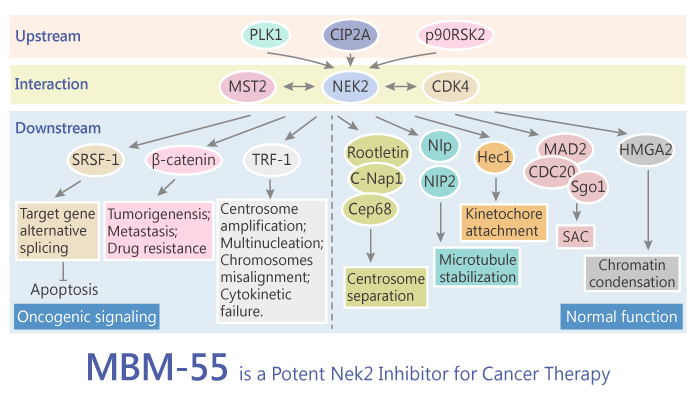NIMA-related kinase 2 (Nek2) is a serine/threonine kinase. It serves as a key regulator of mitotic processes such as centrosome duplication and spindle assembly. Deregulation of mitotic processes can lead to genomic instability and aneuploidy. It is a characteristic of all tumors and is a hallmark of cancer.
Nek2 expression is varied during the cell cycle. Meanwhile, it has maximal expression between the S and G2 phases. Furthermore, Nek2 actively participates in the spindle assembly checkpoint (SAC) process through interaction with kinetochore proteins mitotic arrest deficient 1/2 and by phosphorylating the kinetochore protein Hec1. Nek2 overexpression has an association with aggressive cancer phenotypes and poor prognosis in many malignancies. Nek2 expression in cancer cells is directly related to enhancing genomic instability, cell proliferation, and drug resistance. Therefore, Nek2 represents a novel biomarker to predict cancer prognosis and drug resistance.
MBM-55 is a potent Nek2 inhibitor with an IC50 of 1 nM with antitumor activities. In addition, it shows a 20-fold or greater selectivity in most kinases with the exception of RSK1 (IC50=5.4 nM) and DYRK1a (IC50=6.5 nM).

In vitro, MBM-55 inhibits MGC-803, HCT-116, Bel-7402 cells proliferation with IC50s of 0.53, 0.84, 7.13 μM, respectively. Furthermore, MBM-55 accumulates HCT-116 cells in the G2/M phase with >4N DNA content. It also causes cell apoptosis in a concentration-dependent manner in HCT-116 cells.
In vivo, MBM-55 exhibits good antitumor activity and a well-tolerated dose schedule in nude mice bearing HCT-116 xenografts. Meanwhile, it shows no obvious signs of toxicity.
In summary, MBM-55 exerts excellent efficacy and pharmacokinetic properties. Thus, it will serve as excellent lead compounds in the search for a Nek2 preclinical candidate.
Reference:
Xi JB, et al. Eur J Med Chem. 2017 Jan 27;126:1083-1106.